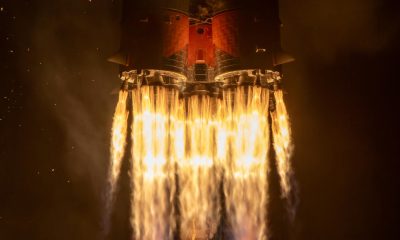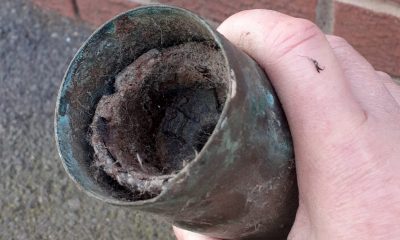DO LOOK UP: NASA’s plan if an asteroid crashes into Earth
Published
2 years ago onBy
Talker News
By Dean Murray via SWNS
NASA announced Thursday (March 10) they have spent the last month preparing for an asteroid impact.
The U.S. space agency has been working closely with FEMA (Federal Emergency Management Agency) and the United States Space Command to analyze response to the impact near Winston-Salem, North Carolina.
Thankfully, the “substantial regional damage” that would ensue is only part of a first-ever simulation designed to assess America’s ability to respond effectively to an asteroid impact threat to Earth.
The government agencies, along with other federal, state and local agencies, convened for the fourth iteration of the so-called Planetary Defense Interagency Tabletop Exercise.
Lindley Johnson, planetary defense officer at NASA Headquarters, explains: “While NASA has previously led and participated in simulated asteroid impact scenarios, this specific exercise marked the first time an end-to-end simulation of this type of disaster was studied, to include assessing a scenario from discovery of the asteroid impact threat through the aftermath effects of its hypothetical impact with Earth.”
Later this year, NASA’s Double Asteroid Redirection Test (DART) will be the world’s first mission to demonstrate technology for defending Earth against potential asteroid impacts.
DART, which is currently on its way to a well-known asteroid that is not a threat to Earth, will squarely impact the moon of the asteroid to change its motion in space such that it can be accurately measured using ground-based telescopes.
“An asteroid impact to our planet is potentially the only natural disaster humanity is capable of accurately predicting and preventing,” says Lindley Johnson. “Conducting exercises of this nature enable government stakeholders to identify and resolve potential issues before real-world actions to respond to an actual asteroid impact threat would ever be needed.”

While there are no predicted asteroid impact threats to our planet for the foreseeable future, this exercise—sponsored by NASA and FEMA and hosted by the Johns Hopkins Applied Physics Laboratory (APL) in Laurel, Maryland—focused extensively on federal and state government coordination that would be necessary to respond to such a threat should one ever be discovered.
Conducted in part to address activities called for in the National Near-Earth Object Preparedness Strategy and Action Plan, which outlines the nation’s strategy to address the hazard posed by near-Earth objects (NEOs), exercises of this nature are one of the many activities the government regularly conducts related to potential natural disasters to ensure our nation’s preparedness for any occurrence.
Over the course of two days, multiple U.S. government agency officials worked through a detailed hypothetical scenario in which astronomers “discover” a simulated asteroid, designated 2022 TTX, that has a probability of impacting the Earth six months after its discovery.
As more information was revealed to exercise participants through a series of modules, it became clear the (simulated) asteroid, which is large enough to cause substantial regional damage, would indeed impact Earth near Winston-Salem, North Carolina.
Specific details of the asteroid such as its size—and therefore its impact energy and detailed damage it would cause—remained highly uncertain until just days before the asteroid’s simulated impact, mimicking how this information could unfold in the real world due to limitations of current capabilities, including ground-based radar technology, which requires an object to be within a relatively close proximity to Earth for current facilities to image and analyse.
Thus, exercise participants navigated remaining in close coordination across federal and state government levels to ensure all stakeholders knew how and where to access information as it became available to planetary defence experts.

“FEMA is an ‘all-hazards’ agency and responds to all domestic disasters and emergencies, so when it became evident this simulated asteroid would impact somewhere within the United States, it required this level of interagency coordination” said Leviticus “L.A.” Lewis, FEMA Detailee to Planetary Defense Coordination Office at NASA Headquarters. “This fourth interagency asteroid impact tabletop exercise provided a forum for federal and local government officials to work through what an impending asteroid impact threat to the United States would look like, with the real people that would be needed for such discussions given this type of impact scenario.”
The completion of this interagency asteroid impact exercise marks another important milestone for the agency’s efforts in planetary defence, which continue to ramp up.
NASA’s Double Asteroid Redirection Test (DART) is designed to validate asteroid deflection computer models and demonstrate kinetic impact deflection as one viable method of responding to a future asteroid threat. However, for technology like DART to be viable, it is imperative an impact threat be discovered with enough warning time—many years to a decade in advance.
Thus, the development continues on the agency’s Near-Earth Object Surveyor mission (NEO Surveyor), which will be an infrared space telescope specifically designed to expedite the agency’s ability to discover and characterize most of the potentially hazardous NEOs, including those that may approach Earth from the daytime sky.
An after-action report for this specific exercise is currently in work and expected to be released publicly later this year.
Stories and infographics by ‘Talker Research’ are available to download & ready to use. Stories and videos by ‘Talker News’ are managed by SWNS. To license content for editorial or commercial use and to see the full scope of SWNS content, please email [email protected] or submit an inquiry via our contact form.
You may like


NASA announces winners of annual Photographer of the Year awards


US Air Force holds first-ever AI vs. human dogfight with fighter jets


NASA’s ‘Dragonfly’ spacecraft will explore Saturn’s biggest moon Titan


Scientists solve mystery of why Pluto has a heart


Runaway cows turn themselves in at animal rescue center


New ‘ghostly’ ant named after Harry Potter villain Voldemort
Other Stories


New breakthrough treatment boosts cancer-fighting cells
The approach involves activating the immune cells in the body and "reprogramming" them to attack and destroy the cancer cells.


One-year-old can’t stop laughing during first ride at Disneyland
"We didn't expect him to love it that much."


Dad running marathon wearing chainmail weighing over 40 pounds
A dad is attempting to break the world record for the fastest marathon while wearing chainmail.


Hero saves elderly couple by dragging them out of burning car
The Good Samaritan jumped into action after spotting the fire on his way to work.


Bomb squad seals off town after ammunition shell donated to charity shop
Staff discovered the device in a bag of donations.
Top Talkers

 Parenting1 day ago
Parenting1 day agoSingle mom details struggles of feeding her 12 kids

 Broadcast3 days ago
Broadcast3 days agoOver 40% of Americans have no clue what a 401k is

 Broadcast2 days ago
Broadcast2 days agoHow hard is it for Americans to live sustainably?

 Broadcast1 week ago
Broadcast1 week agoGrocery shopping hungry is costing Americans this much

 Funny1 week ago
Funny1 week agoCops confused by crow mimicking police siren

 Shopping1 week ago
Shopping1 week agoGrocery shopping hungry costs Americans this much every trip

 Money3 days ago
Money3 days agoOver 40% of Americans have no clue what a 401k is

 Parenting1 week ago
Parenting1 week agoIt takes this many minutes for the average American kid to get bored
